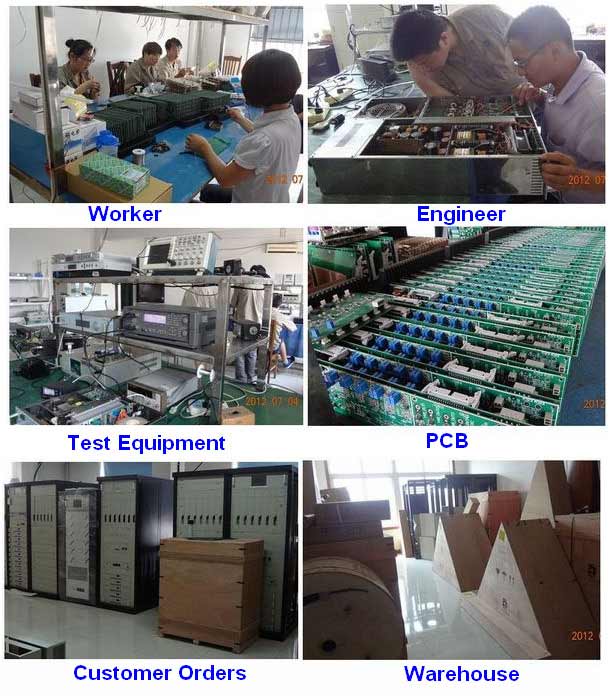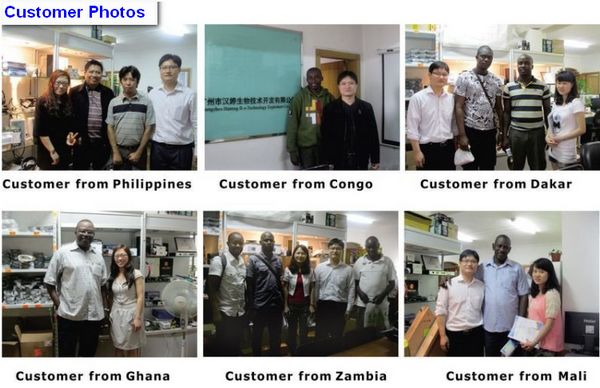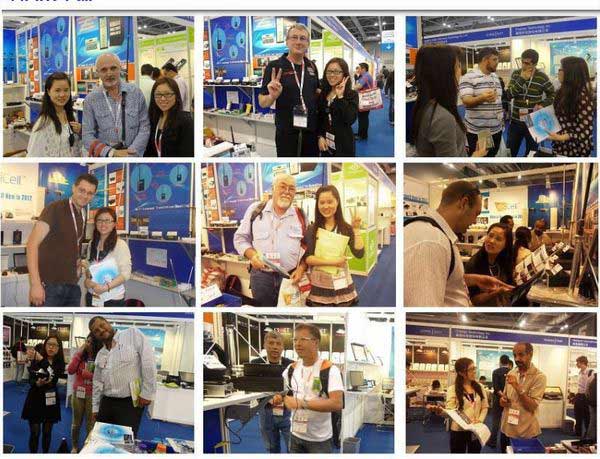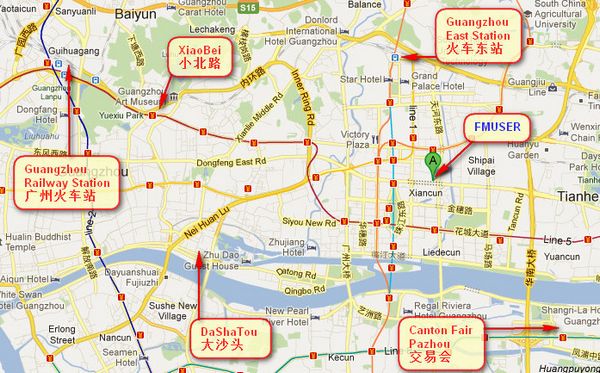In the current IPTV business, the choice of audio and video codec technology presents a three-pronged situation, namely MPEG4ASP, H.264 and AVS. Among them, MPEG4 and H.264 are standards of related international organizations, and AVS is the national standard of China. As an important link in the IPTV industry chain, telecom operators such as China Telecom and China Netcom have similar views on the development of audio and video coding and decoding technologies, and they are all pushing H.264. At the same time, they have shown a wait-and-see attitude towards AVS, indicating that it is possible in the future. Will require IPTV equipment vendors to support AVS.
Compared with H.264 and AVS technical standards, MPEG4ASP has the earliest start time and the highest degree of industrialization in the streaming media and IPTV application market. Therefore, it has received the most extensive support from IPTV equipment providers at this stage. In addition, another important link in the domestic IPTV industry chain (content operators) also tends to MPEG4. Among the three, AVS has the lowest degree of industrialization, followed by H.264.
From a market perspective, MPEG2 products have the most mature technology and are the most widely used in the foreign IPTV market. They have also been recognized and widely used in the domestic digital broadcast television market. Since Microsoft's VC-1 or WM9 are standards of foreign manufacturers, no matter from the perspective of the development of the IPTV industry or the digital broadcasting and television industry, it has neither been recognized by the National Standardization Organization nor received strong support from domestic operators. .
1. Formulation of standards
First of all, we need to understand the meaning of various standards in the domestic IPTV industry. The current standards in the IPTV industry mainly refer to national standards, industry standards and corporate standards. National standards are formulated and promulgated by the standardization administrative department (National Standardization Management Committee), industry standards are formulated and promulgated by the competent ministries and commissions, and enterprise standards are formulated by enterprises themselves. National standards and industry standards can be divided into mandatory standards and recommended standards.
At present, there is no national IPTV standard in the IPTV industry. The relevant departments of the Ministry of Information Industry are currently formulating an IPTV industry standard, which may become a national standard for IPTV in the future. AVS is a recommended national audio and video coding and decoding technology standard, which will be recommended and referenced in the IPTV industry standard. The IPTV standards formulated by China Netcom and China Telecom are all IPTV corporate standards. If the radio and television departments also formulate relevant IPTV industry standards, their specifications will also have an important impact on the choice of IPTV audio and video codec technology.
To be precise, the current dispute over audio and video codec technology standards in the domestic IPTV industry is mainly reflected in the choice of video codec technology in the IPTV standard, and the choice of audio codec technology has not been experienced in the industry. Many arguments and detailed considerations. In the IPTV system, the video and audio codec technologies are relatively independent. For example, the current IPTV system equipment of different manufacturers supports one or more of different audio codec technologies such as MPEG1LAYER2 (MP2), MPEG1LAYER3 (MP3), MPEG2AAC, MPEG4AAC, etc. Kinds of audio formats.
foreign or local?
Audio and video encoding and decoding technology is the key technology of digital audio and video, and it is widely used in industries such as digital TV, IPTV, mobile TV, VCD/DVD players, and various other digital media terminal equipment. For simple economic reasons, the use of foreign audio and video coding and decoding technology standards will not only pay huge patent fees, but also the standard, as the most upstream of the industry chain, directly affects the entire industry such as chips, software, front-end equipment, storage, transmission, and terminal equipment. chain.
AVS, as a standard with independent intellectual property rights in China, not only enables Chinese companies to avoid the trouble of patent fees, but also plays a strategic role in protecting and promoting the healthy development of domestic digital audio and video-related industries. It is under this background that AVS was officially promulgated as the national audio and video coding standard in February 2006, and following the video part, audio, mobile video, systems, digital rights management and other parts will be approved and released one after another. Based on many reasons such as technology, economy, IPTV policy, industrial protection, etc., the choice of audio and video codec technology in the domestic IPTV industry not only involves IPTV equipment providers, telecom operators, content providers, chip providers, but also content operators. , The Ministry of Information Industry, the domestic AVS standards organization and other links are closely related.
As the IPTV industry standard setter, the Ministry of Information Industry of the People's Republic of China aims to protect the healthy development of the entire domestic industrial chain and promote the best social benefits. The AVS working group itself has received key support from the Ministry of Information Industry, so it can It is foreseen that AVS will serve as the basic choice of IPTV industry standard audio and video codec technology. At present, AVS is in the process of from standardization to industrialization, and AVS-based codec chips, encoders, set-top boxes, etc. have not yet been commercialized.
Since the AVS standard has just been promulgated and the productization has not yet begun on a large scale, it is easy to understand why MPEG4 has received more support from the broadcasting and television departments and IPTV equipment providers at this stage. Compared with AVS and H.264, MPEG4 codec equipment and streaming media server applications are more mature and extensive, and the content stored in MPEG4 format is also more extensive. However, although MPEG4 started early, the vigorous development of MPEG4 is largely based on the launch of the domestic IPTV market.
For H.264, in addition to its technological advancement, another important reason for domestic telecom operators to push H.264 is because H.264 evades MPEG4's patent charges to operators, that is to say, H.264's The way of collecting patent fees has dispelled the shadow of MPEG4 fees that had previously been shrouded in domestic telecom operators. So even in the current situation where the cost of H.264 is higher than that of MPEG4, H.264 still makes domestic telecom operators happy and excited.
In 2002, MPEG-LA announced the patent fee for MPEG4. In addition to the fixed codec fee, the content owner and content provider must also be charged corresponding fees based on the playing time. For the domestic IPTV industry, in addition to content operators, IPTV operators also need to pay related patent fees.
This caused an uproar in the industry and directly became an external factor to promote the pace of the H.264 market. However, disappointingly, in the first half of 2005, the owners of the H.264 patent pool announced the procedures for charging through two authorized agents of MPEG-LA and VIALicensing, and announced that they would start on January 1, 2006. Official fees. It is hoped that H.264 will be used to avoid MPEG4's purpose of charging for IPTV operations and has not been achieved. What is even more discouraging is that the existence of two patent agency organizations also complicates the problem, and may even cause patent users to have to face these two organizations at the same time, because they each represent a portion of patent owners.
Although chip manufacturers already know that H.264 patents are intricate and the industrialization process still needs time, they obviously did not anticipate that operators and terminal manufacturers in the domestic IPTV market will be so eager for H.264 technology upgrades, which makes them insufficiently prepared. . However, as the upstream of the industry chain, chip manufacturers are always the first batch of manufacturers to intervene in the H.264 field, so even though they themselves are not willing that MPEG4 chips have not yet brought enough profits, they will be replaced by H.264 chips. Appeared, but still accelerated the development process of H.264 chip.
From the perspective of chip implementation, the efficiency of H.264 is based on the high complexity of its implementation. In terms of its Baseline, the decoder complexity will be about 3 times that of the H.263 decoder. The complexity of the encoder is up to more than 10 times. In addition, because video processing is a data processing-oriented system, combined with video processing algorithms, the realization of instruction operand loading and parallel operations will greatly improve the efficiency of data processing.
In H.264, motion estimation uses a multi-frame reference technology, which requires the processor architecture to have new considerations for the processor's data scheduling mechanism and the organization of on-chip and off-chip memory. H.264, like previous standards, can perform parallel processing based on pictures, slices, and macroblocks. H.264 also uses the RD algorithm for mode selection, and all modes are not correlated during calculation, that is, they can be operated in parallel. To adapt to the parallel processing characteristics of the H.264 encoder to adapt to the implementation of the high-complexity H.264 algorithm, the processing chip architecture needs to develop from a single-core architecture with insufficient processing power to a dual-core and multi-core architecture. An effective way to improve the performance of multimedia processing chips in the next few years. But what follows is that the software work difficulty of the multimedia processing chip (such as compiler, operating system task scheduling, etc.) will be greatly increased, prolonging the implementation cycle of the H.264 chip and the product maturity cycle.
Although the existing IPTV set-top boxes using TIDM642 processors can support H.264 standard-definition decoding, for the IPTV value-added services that broadband operators have been looking forward to, such as video phones and other audio and video services that require set-top box encoding, the There are multimedia processing chips that are limited by performance and cannot provide good support, which makes this type of service impossible to realize and brings considerable technical risks to IPTV services. Moreover, the high cost of the set-top box supporting H.264 at this stage has greatly increased the market input cost of the IPTV service and increased the market risk of the IPTV service at the same time.
In contrast to MPEG-4ASP, since the MPEG organization first announced the MPEG-4 technology in November 1998, there has been a considerable period of time as the basis for development, and a large number of mature technology chips have been born and put into large-scale applications. Most of these chips used in MPEG-4 have undergone a long period of technical testing and have good compatibility and stability. In addition to continuous improvement in technology, in terms of price, the average unit price has gradually decreased. With the support of these chips, broadband operators can launch similar value-added services as soon as possible.
Because of this, if H.264 cannot be quickly applied on a large scale in the domestic IPTV market, MPEG4 chips will still have advantages in software and hardware development costs compared to H.264 chips during this period, and H.264 still needs huge cost investment. In addition, chip manufacturers still need time to stabilize and improve existing H.264 chips. It is the consideration of cost and stability that restricts and affects the large-scale commercial use of H.264.
2. The market decides the way out
It is predicted that by 2008, China's broadband users will increase to 100 million. If 20% of them become Internet TV users, then the number of IPTV users will reach 20 million; if the current cable TV users have 20% before 2008 Become a network TV user, then the number of users will reach 20 million; mobile users are estimated to exceed 400 million by the end of 2005, and if 5% of them become network TV users before 2008, the number of users will also reach 20 million Household. On this basis, it is estimated that the total number of IPTV users will reach 60 million by 2008.
Let us take another look at the selection of traditional domestic radio and television codec technologies that have the greatest impact on the industrialization of audio and video codecs. The digital TV channel of CCTV uses the foreign MPEG-2 standard. The reason is to ensure the fidelity of signal transmission. MPEG-2 has been developed for a long time and the technology is relatively mature; the second is for copyright protection, because CCTV wants to introduce a lot of foreign digital TV program content, and the other party agrees. The MPEG-2 codec standard feels that it can better protect its copyright. In addition, there are currently more than 1 million digital cable TV users across the country, and they also use the MPEG-2 standard. If it is replaced with the AVS standard, there will inevitably be a cost problem of replacing a set-top box.
From the application point of view, observe the market situation of audio and video codec technology. In broadcasting and DVD applications, MPEG2 is still in the mainstream, but in mobile TV, video conferencing, video surveillance, and video phones, H.264 and MPEG4 are widely used. From the product application level, DVD is currently the largest application market for codecs, and the next stage of growth is expected to occur in the video application field of mobile terminals, such as watching digital TV with handheld devices, personal media players, etc. Compared with MPEG4, H.264 will be more widely used in these areas.
On the whole, H.264 is supported by telecom operators and equipment providers. Whether it is in the Internet or other application fields, H.264 has a dominant position in the future market. For the IPTV industry, it is a foregone conclusion that H.264 will replace MPEG4, but the commercial cost of H.264 will still hinder its large-scale application in the short term. As for AVS, because it has the advantage of reducing patent fees for domestic enterprises and is supported by the Chinese government, its application in China is worth looking forward to.
From the perspective of development, audio and video codec technology is always in the process of continuous evolution. Therefore, what is placed in front of IPTV equipment providers is not the choice of which audio and video codec technology, but whether their IPTV system and solutions can achieve transparency at the media transmission layer and the codec format, and expand in the system. In terms of sex, it can be quickly and seamlessly upgraded to support various current and future codec technologies.



|
|
|
|
How far(long) the transmitter cover?
The transmission range depends on many factors. The true distance is based on the antenna installing height , antenna gain, using environment like building and other obstructions , sensitivity of the receiver, antenna of the receiver . Installing antenna more high and using in the countryside , the distance will much more far.
EXAMPLE 5W FM Transmitter use in the city and hometown:
I have a USA customer use 5W fm transmitter with GP antenna in his hometown ,and he test it with a car, it cover 10km(6.21mile).
I test the 5W fm transmitter with GP antenna in my hometown ,it cover about 2km(1.24mile).
I test the 5W fm transmitter with GP antenna in Guangzhou city ,it cover about only 300meter(984ft).
Below are the approximate range of different power FM Transmitters. ( The range is diameter )
0.1W ~ 5W FM Transmitter :100M ~1KM
5W ~15W FM Ttransmitter : 1KM ~ 3KM
15W ~ 80W FM Transmitter : 3KM ~10KM
80W ~500W FM Transmitter : 10KM ~30KM
500W ~1000W FM Transmitter : 30KM ~ 50KM
1KW ~ 2KW FM Transmitter : 50KM ~100KM
2KW ~5KW FM Transmitter : 100KM ~150KM
5KW ~10KW FM Transmitter : 150KM ~200KM
How to contact us for the transmitter?
Call me +8618078869184 OR
Email me [email protected]
1.How far you want to cover in diameter ?
2.How tall of you tower ?
3.Where are you from ?
And we will give you more professional advice.
About Us
FMUSER.ORG is a system integration company focusing on RF wireless transmission / studio video audio equipment / streaming and data processing .We are providing everything from advice and consultancy through rack integration to installation, commissioning and training.
We offer FM Transmitter, Analog TV Transmitter, Digital TV transmitter, VHF UHF Transmitter, Antennas, Coaxial Cable Connectors, STL, On Air Processing, Broadcast Products for the Studio, RF Signal Monitoring, RDS Encoders, Audio Processors and Remote Site Control Units, IPTV Products, Video / Audio Encoder / Decoder, designed to meet the needs of both large international broadcast networks and small private stations alike.
Our solution has FM Radio Station / Analog TV Station / Digital TV Station / Audio Video Studio Equipment / Studio Transmitter Link / Transmitter Telemetry System / Hotel TV System / IPTV Live Broadcasting / Streaming Live Broadcast / Video Conference / CATV Broadcasting system.
We are using advanced technology products for all the systems, because we know the high reliability and high performance are so important for the system and solution . At the same time we also have to make sure our products system with a very reasonable price.
We have customers of public and commercial broadcasters, telecom operators and regulation authorities , and we also offer solution and products to many hundreds of smaller, local and community broadcasters .
FMUSER.ORG has been exporting more than 15 years and have clients all over the world. With 13 years experience in this field ,we have a professional team to solve customer's all kinds of problems. We dedicated in supplying the extremely reasonable pricing of professional products & services. Contact email : [email protected]
Our Factory

We have modernization of the factory . You are welcome to visit our factory when you come to China.

At present , there are already 1095 customers around the world visited our Guangzhou Tianhe office . If you come to China , you are welcome to visit us .
At Fair

This is our participation in 2012 Global Sources Hong Kong Electronics Fair . Customers from all over the world finally have a chance to get together.
Where is Fmuser ?

You can search this numbers " 23.127460034623816,113.33224654197693 " in google map , then you can find our fmuser office .
FMUSER Guangzhou office is in Tianhe District which is the center of the Canton . Very near to the Canton Fair , guangzhou railway station, xiaobei road and dashatou , only need 10 minutes if take TAXI . Welcome friends around the world to visit and negotiate .
Contact: Sky Blue
Cellphone: +8618078869184
WhatsApp: +8618078869184
Wechat: +8618078869184
E-mail: [email protected]
QQ: 727926717
Skype: sky198710021
Address: No.305 Room HuiLan Building No.273 Huanpu Road Guangzhou China Zip:510620
|
|
|
|
English: We accept all payments , such as PayPal, Credit Card, Western Union, Alipay, Money Bookers, T/T, LC, DP, DA, OA, Payoneer, If you have any question , please contact me [email protected] or WhatsApp +8618078869184
-
PayPal.  www.paypal.com www.paypal.com
We recommend you use Paypal to buy our items ,The Paypal is a secure way to buy on internet .
Every of our item list page bottom on top have a paypal logo to pay.
Credit Card.If you do not have paypal,but you have credit card,you also can click the Yellow PayPal button to pay with your credit card.
---------------------------------------------------------------------
But if you have not a credit card and not have a paypal account or difficult to got a paypal accout ,You can use the following:
Western Union.  www.westernunion.com www.westernunion.com
Pay by Western Union to me :
First name/Given name: Yingfeng
Last name/Surname/ Family name: Zhang
Full name: Yingfeng Zhang
Country: China
City: Guangzhou
|
---------------------------------------------------------------------
T/T . Pay by T/T (wire transfer/ Telegraphic Transfer/ Bank Transfer)
First BANK INFORMATION (COMPANY ACCOUNT):
SWIFT BIC: BKCHHKHHXXX
Bank name: BANK OF CHINA (HONG KONG) LIMITED, HONG KONG
Bank Address: BANK OF CHINA TOWER, 1 GARDEN ROAD, CENTRAL, HONG KONG
BANK CODE: 012
Account Name : FMUSER INTERNATIONAL GROUP LIMITED
Account NO. : 012-676-2-007855-0
---------------------------------------------------------------------
Second BANK INFORMATION (COMPANY ACCOUNT):
Beneficiary: Fmuser International Group Inc
Account Number: 44050158090900000337
Beneficiary's Bank: China Construction Bank Guangdong Branch
SWIFT Code: PCBCCNBJGDX
Address: NO.553 Tianhe Road, Guangzhou, Guangdong,Tianhe District, China
**Note: When you transfer money to our bank account, please DO NOT write anything in the remark area, otherwise we won't be able to receive the payment due to government policy on international trade business.
|
|
|
|
* It will be sent in 1-2 working days when payment clear.
* We will send it to your paypal address. If you want to change address, please send your correct address and phone number to my email [email protected]
* If the packages is below 2kg,we will be shipped via post airmail, it will take about 15-25days to your hand.
If the package is more than 2kg,we will ship via EMS , DHL , UPS, Fedex fast express delivery,it will take about 7~15days to your hand.
If the package more than 100kg , we will send via DHL or air freight. It will take about 3~7days to your hand.
All the packages are form China guangzhou.
* Package will be sent as a "gift" and declear as less as possible,buyer don't need to pay for "TAX".
* After ship, we will send you an E-mail and give you the tracking number.
|
|
|
For Warranty .
Contact US--->>Return the item to us--->>Receive and send another replace .
Name: Liu xiaoxia
Address: 305Fang HuiLanGe HuangPuDaDaoXi 273Hao TianHeQu Guangzhou China.
ZIP:510620
Phone: +8618078869184
Please return to this address and write your paypal address,name,problem on note: |
|

























